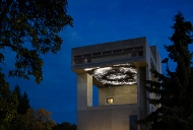Leo Villareal: Cosmos
Date uploaded: November 21, 2012
The Herbert F. Johnson Museum of Art at Cornell University presents Leo Villareal: Cosmos. A homage to the late Cornell astronomy professor Carl Sagan, Cosmos is the most recent site-specific installation by New York-based artist Leo Villareal (b. 1967), a pioneer in the use of light-emitting diodes (LEDs) and computer-driven imagery. His signature pieces explore complex movement and dazzling patterns created by points of light using his own computer software.
Planning for Cosmos began in November 2010, when Villareal - along with the project architect, Walter Smith AIA LEED AP, and donors Lisa and Richard Baker - worked with Johnson Museum staff to determine the optimal location for the installation. The 45 x 68 foot ceiling of the Sherry and Joel Mallin Sculpture Court was chosen for its high visibility not only on campus but also from the city of Ithaca. Cosmos is made up of twelve thousand energy-efficient LEDs attached to a gridded framework. A zero gravity bench, 25 feet long, was especially designed by the artist for viewers to fully immerse themselves in the viewing experience and to foster a more communal involvement with his installation.
While Villareal developed many of the light patterns on the computer in his studio, final imagery also came from direct observation on site, such as cloud movement and flocks of geese flying over Ithaca in early fall. "It's almost like a musical instrument that you have to tune and get just right," said the artist. "It's a process of discovery, because I don't know in advance what it's going to be."
Villareal spent a week in residence at Cornell, adjusting his programming from a variety of vantage points on the Museum grounds. "It is especially exciting to view the installation at nighttime, when the patterns of light make the ceiling disappear and turn it into a void—light trumping matter," said Andrea Inselmann, curator of modern and contemporary art at the Johnson Museum. Commenting on this interaction between the existing architecture and his installation, Villareal has noted, "The challenge for me is to find a way to do it that respects what's here but that adds another layer that can really invigorate the building and make people look at it in a new way."
Among Villareal's most notable site-specific works are the illumination of the exterior of the Brooklyn Academy of Music (2006), Multiverse in the Concourse walkway between the East and West Buildings at the National Gallery of Art (2008), and Sky at the Tampa Museum of Art (2009).
Villareal recently completed the monumental sculpture Buckyball for the Madison Square Park Conservancy's Madison Square Art and a Metropolitan Transportation Authority commission in the Bleecker Street/Lafayette Street subway station in Manhattan. His largest installation to date will be The Bay Lights, illuminating the West Span of the San Francisco Bay Bridge for its 75th anniversary beginning in 2013.

